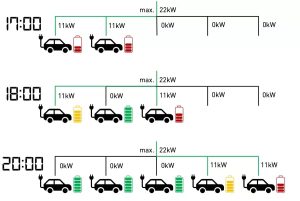Load Management Electric Car Charging

Load Management Requirements in Electric Car Charging
Load management is crucial when the electrical capacity of a building is exceeded by the power demand for charging multiple electric vehicles (EVs), whether at a distribution board, sub-board, or main switchboard level. Even if this functionality is not immediately necessary, it will be vital for allowing almost all lot owners to charge their EVs in the future. Without load management, an EV charging station has a power factor of 1, as EVs require significant electricity for prolonged periods. Each EV charger has the same impact as adding a commercial-grade air conditioning system.
Load Management is the most advanced safety feature offered by the Ocular IQ Solar system. This feature helps protect the properties’ electrical infrastructure while maintaining efficient operation of the charging infrastructure. Unlike other appliances, EV charging stations consume a large amount of power when in use. If there isn’t any form of load control, these stations may cause unexpected power outages or damage the electrical Infrastructure of the property.
The Ocular IQ Solar system has the functionality and capability to do 3 forms of load management with active load management (ALM) being the most advanced form of dynamically managing the EV charging system based on available power.

The image above summarises the requirement for load management in an apartment situation. The available load of 22kW is distributed safely as the resident’s plug-in, the load is limited to ensure the building’s electricity supply is safe.
Load management allows for more powerful EV Chargers to be installed with the building’s power resources being shared amongst the fleet of chargers. Therefore, a 22kW system can be installed instead of a 3.7kW charger with the load balanced automatically. This is essential for vehicles such as the Tesla that have large batteries that require fast chargers to provide the necessary range. A Tesla charging station with load management provides increasing range without the required electrical upgrades.
The Ocular IQ Solar offers 3 forms of Load Management to help maximise charging speeds.
- Static Load Management
Static load management is a straightforward approach where the available power is divided among charging stations based on predefined rules. The Ocular IQ Solar system allows for this method, ensuring that the total power draw does not exceed the capacity of the electric system.
Key Features of Static Load Management
- Fixed Power Distribution: Power is distributed evenly or according to a fixed schedule, regardless of real-time demand.
- Simple Implementation: Easier to implement as it does not require complex real-time monitoring and control systems.
- Limited Flexibility: Does not adapt to changing demand or prioritise charging based on need, which can lead to inefficiencies.
Static load management is suitable for smaller installations where power demand is predictable and manageable without dynamic adjustments.
- Active Load Management
Active load management, as facilitated by the Ocular IQ Solar system, dynamically adjusts the power distribution to optimise charging efficiency and prevent overloading of the electrical system. This approach uses real-time data and intelligent algorithms to manage the load more effectively.
Key Features of Active Load Management
- Real-Time Monitoring: Continuously monitors the power usage and adjusts the charging rate based on real-time conditions.
- Priority Charging: Can prioritise charging for certain vehicles or users, such as those with immediate needs or higher status.
- Maximised Efficiency: Ensures optimal use of available power, reducing wait times and improving the overall user experience.
- Scalability: More suitable for larger installations or areas with variable power demands and numerous charging points.
With the Ocular IQ Solar, active load management requires a more complex setup, involving cutting-edge technology and software that can interpret data and make decisions in real time.
- Scheduled EV Charging
The goal of scheduled EV charging is to better control the load and take advantage of cheaper electricity during off-peak hours. This is done by scheduling charging sessions according to predetermined timings.
Benefits of Scheduled EV Charging:
- Cost Savings: Charging during off-peak hours can significantly reduce the cost to charge your vehicle.
- Load Balancing: Helps distribute the load more evenly across the day, preventing peaks that can strain the electrical system.
- User Convenience: Allows users to plan their charging around their schedules, ensuring their vehicle is ready when needed.
- Grid Stability: Contributes to overall grid stability by smoothing out demand fluctuations.
Implementing Scheduled EV Charging with Ocular IQ Solar
- User communication: Inform users about the benefits and process of scheduled charging
- Flexible Scheduling: Provide tools for users to set their preferred charging times while considering grid conditions.
- Incentives: Offer incentives for users who participate in scheduled charging programs, such as discounted rates.
Installing and operating EV charging infrastructure successfully depends on effective load management. Businesses and utilities can employ both static and active load management strategies with the Ocular IQ Solar system to guarantee effective, dependable, and user-friendly charging services. In addition, there are a number of financial and grid stability advantages to be gained from introducing regular EV charging. Investing in cutting-edge load management systems, such as the Ocular IQ Solar system, will be essential to facilitating the shift towards electric vehicles while preserving a reliable and effective electrical infrastructure.
Have any questions? Contact us:
Phone: 0800 990 032
Email: sales@evse.nz


